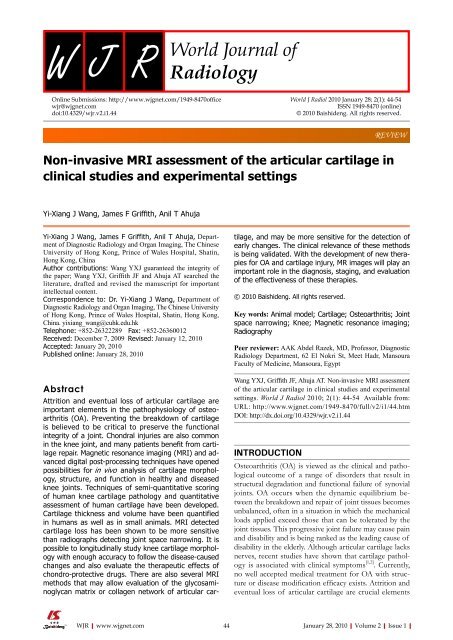World Journal of Radiology - World Journal of Gastroenterology
World Journal of Radiology - World Journal of Gastroenterology
World Journal of Radiology - World Journal of Gastroenterology
You also want an ePaper? Increase the reach of your titles
YUMPU automatically turns print PDFs into web optimized ePapers that Google loves.
W J R<br />
Online Submissions: http://www.wjgnet.com/1949-8470<strong>of</strong>fice<br />
wjr@wjgnet.com<br />
doi:10.4329/wjr.v2.i1.44<br />
REVIEW<br />
Non-invasive MRI assessment <strong>of</strong> the articular cartilage in<br />
clinical studies and experimental settings<br />
Yi-Xiang J Wang, James F Griffith, Anil T Ahuja<br />
Yi-Xiang J Wang, James F Griffith, Anil T Ahuja, Department<br />
<strong>of</strong> Diagnostic <strong>Radiology</strong> and Organ Imaging, The Chinese<br />
University <strong>of</strong> Hong Kong, Prince <strong>of</strong> Wales Hospital, Shatin,<br />
Hong Kong, China<br />
Author contributions: Wang YXJ guaranteed the integrity <strong>of</strong><br />
the paper; Wang YXJ, Griffith JF and Ahuja AT searched the<br />
literature, drafted and revised the manuscript for important<br />
intellectual content.<br />
Correspondence to: Dr. Yi-Xiang J Wang, Department <strong>of</strong><br />
Diagnostic <strong>Radiology</strong> and Organ Imaging, The Chinese University<br />
<strong>of</strong> Hong Kong, Prince <strong>of</strong> Wales Hospital, Shatin, Hong Kong,<br />
China. yixiang_wang@cuhk.edu.hk<br />
Telephone: +852-26322289 Fax: +852-26360012<br />
Received: December 7, 2009 Revised: January 12, 2010<br />
Accepted: January 20, 2010<br />
Published online: January 28, 2010<br />
Abstract<br />
Attrition and eventual loss <strong>of</strong> articular cartilage are<br />
important elements in the pathophysiology <strong>of</strong> osteoarthritis<br />
(OA). Preventing the breakdown <strong>of</strong> cartilage<br />
is believed to be critical to preserve the functional<br />
integrity <strong>of</strong> a joint. Chondral injuries are also common<br />
in the knee joint, and many patients benefit from cartilage<br />
repair. Magnetic resonance imaging (MRI) and advanced<br />
digital post-processing techniques have opened<br />
possibilities for in vivo analysis <strong>of</strong> cartilage morphology,<br />
structure, and function in healthy and diseased<br />
knee joints. Techniques <strong>of</strong> semi-quantitative scoring<br />
<strong>of</strong> human knee cartilage pathology and quantitative<br />
assessment <strong>of</strong> human cartilage have been developed.<br />
Cartilage thickness and volume have been quantified<br />
in humans as well as in small animals. MRI detected<br />
cartilage loss has been shown to be more sensitive<br />
than radiographs detecting joint space narrowing. It is<br />
possible to longitudinally study knee cartilage morphology<br />
with enough accuracy to follow the disease-caused<br />
changes and also evaluate the therapeutic effects <strong>of</strong><br />
chondro-protective drugs. There are also several MRI<br />
methods that may allow evaluation <strong>of</strong> the glycosaminoglycan<br />
matrix or collagen network <strong>of</strong> articular car-<br />
WJR|www.wjgnet.com<br />
<strong>World</strong> <strong>Journal</strong> <strong>of</strong><br />
<strong>Radiology</strong><br />
tilage, and may be more sensitive for the detection <strong>of</strong><br />
early changes. The clinical relevance <strong>of</strong> these methods<br />
is being validated. With the development <strong>of</strong> new therapies<br />
for OA and cartilage injury, MR images will play an<br />
important role in the diagnosis, staging, and evaluation<br />
<strong>of</strong> the effectiveness <strong>of</strong> these therapies.<br />
© 2010 Baishideng. All rights reserved.<br />
Key words: Animal model; Cartilage; Osteoarthritis; Joint<br />
space narrowing; Knee; Magnetic resonance imaging;<br />
Radiography<br />
Peer reviewer: AAK Abdel Razek, MD, Pr<strong>of</strong>essor, Diagnostic<br />
<strong>Radiology</strong> Department, 62 El Nokri St, Meet Hadr, Mansoura<br />
Faculty <strong>of</strong> Medicine, Mansoura, Egypt<br />
Wang YXJ, Griffith JF, Ahuja AT. Non-invasive MRI assessment<br />
<strong>of</strong> the articular cartilage in clinical studies and experimental<br />
settings. <strong>World</strong> J Radiol 2010; 2(1): 44-54 Available from:<br />
URL: http://www.wjgnet.com/1949-8470/full/v2/i1/44.htm<br />
DOI: http://dx.doi.org/10.4329/wjr.v2.i1.44<br />
INTRODUCTION<br />
<strong>World</strong> J Radiol 2010 January 28; 2(1): 44-54<br />
ISSN 1949-8470 (online)<br />
© 2010 Baishideng. All rights reserved.<br />
Osteoarthritis (OA) is viewed as the clinical and pathological<br />
outcome <strong>of</strong> a range <strong>of</strong> disorders that result in<br />
structural degradation and functional failure <strong>of</strong> synovial<br />
joints. OA occurs when the dynamic equilibrium between<br />
the breakdown and repair <strong>of</strong> joint tissues becomes<br />
unbalanced, <strong>of</strong>ten in a situation in which the mechanical<br />
loads applied exceed those that can be tolerated by the<br />
joint tissues. This progressive joint failure may cause pain<br />
and disability and is being ranked as the leading cause <strong>of</strong><br />
disability in the elderly. Although articular cartilage lacks<br />
nerves, recent studies have shown that cartilage pathology<br />
is associated with clinical symptoms [1,2] . Currently,<br />
no well accepted medical treatment for OA with structure<br />
or disease modification efficacy exists. Attrition and<br />
eventual loss <strong>of</strong> articular cartilage are crucial elements<br />
44 January 28, 2010|Volume 2|Issue 1|

















